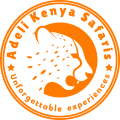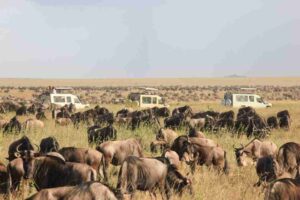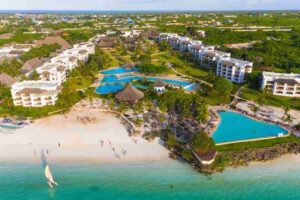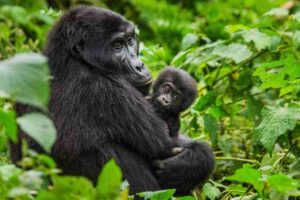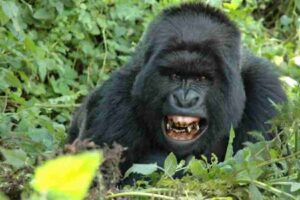| Name of the facility | Samburu Intrepids Camp |
|---|---|
| Certification Achieved | Silver |
| Year opened | 1990 |
| Tourism region | Laikipia/Samburu |
| County | Samburu |
| Address | Samburu Map It |
| Telephone/Mobile | +25422205894 |
| [email protected] | |
| Website | heritage-eastafrica.com |
| Facility Notes | Samburu Intrepids Camp is located within Samburu National Reserve. The camp is specifically located on Global Positioning System (GPS) Coordinates, Latitude 034’46.56”N and Longitude 37 029’38.4”E. It has 28 guest tents with a bed capacity of 56 visitors and a total work force of 62 employees. The facility is built lies on 17 acres (6.87966 hectares) of land under a lease period of 99 years. The Samburu National Reserve is rich in wildlife with an abundance of rare northern species such as the Grevy’s zebra, Somali ostrich, reticulated giraffe, gerenuk and the Beisa Oryx and has over 350 species of birds. Nile Crocodiles are common within the Ewaso Ng’iro River that cuts across the reserve. |
| Energy management | Diesel generators are the camps’ main source of power. There are two (2) generators, with an output capacity of 100 KvA each. The power is used for lighting, and running refrigerators throughout the facility. Generator fuel consumption is closely monitored through recording to enhance efficiency. The generator power is rationed (generators are run on alternate modes) for energy conservation. The rationing is done for nine (9) hours daily. Floodlights within the facility are set on photo cell timers to conserve on energy consumption. The camp has solar water heaters for heating water in the guest rooms, laundry and kitchen. It is well insulated for heat efficiency. A solar powered electric fence is installed. Security flash lights and torches are solar rechargeable. Liquefied petroleum gas (LPG) is used for cooking within the camp. The facility is fixed with energy efficient dimmer lights, energy saving bulbs and light emitting diodes are installed throughout the premise. Guests and staff are briefed and encouraged on energy conservation through departmental meetings and room information folders in the guest tents. In addition, the camp has an energy policy in place to guide operations. |
| Environmental management | Samburu Intrepids Camp is guided by comprehensive corporate environmental policy outlining commitment to sound environmental management, compliance with relevant regulations, pollution prevention, creating awareness and promoting social responsibility through sharing tourism benefits with local communities. The camp has an Environmental Management System (EMS) with management plans for water, energy and waste. |
| Chemical use | The camp uses biodegradable bathroom amenities such as bathing soaps and shampoos in the guest tents supplied by Clique Limited. Diversy Chemicals are used in the laundry whereas Henkel Chemicals are used in the swimming pool. Material Safety Data Sheet (MSDS) for the chemicals are available. Swimming pool chemical test records are conducted on daily basis aimed at monitoring the amount of chemical used – chlorine and algaecide. Fuel (Diesel) is stored in an underground tank of 10,000 litres fixed with a fueling pump. Gas is bought in bulk – 2 tone cylinder. The storage area is properly contained. |
| Conservation Criteria | |
| Community Criteria | |
| Solid waste management | Waste separation within the facility is conducted at source and the bins clearly labelled. Organic waste is composted in a properly sealed pit. Plastics, metallic, glass waste, electric waste are segregated, collected and stored in a waste holding centre awaiting disposal through the central supplies office. Medical waste is packed in safety boxes and disposed off for incineration at Wamba Catholic Mission Hospital |
| Water management | The main source of water for the camp is drawn from two (2) wells within the facility; the water is pumped and stored in reservoirs with an average capacity of 53,000 litres. The facility has a water extraction permit. A meter has been fixed at source and sub meters have also been fixed within main departments including kitchen, laundry, guest and staff quarters in order to monitor consumption. Daily meter reading and recording is conducted. Shower filter heads are fixed with faucets – flow reducers for water use efficiency. Lift taps are also fixed in the guest tents. The facility’s staff are sensitized to enhance water conservation through departmental briefings and guests upon arrival briefing. Laundry machines are automated and load monitoring done to enhance the machines efficiency. The guest tents are fixed with “towel-talks” sensitizing visitors on re-use of towels aimed at water conservation. |
| Visitor communication & education | Guests are briefed upon arrival on the environmental values of the facility. The facility has an environmental resource centre equipped with reading materials, and information on local birdlife, reptiles, and mammals. Astronomy information is also available. Room information folders are equipped with facility operations and available activities information. The facility offers power point presentations to the guests in the evening. The presentations include; wildlife conservation, resources conservation and cultural awareness talks. |
| Pollution | The generators are properly insulated and fixed in a sound proof room. Pathway lights are covered and shaded to minimize light pollution at night. |
| Environmental conservation | The camp holds an environmental day on a weekly basis. General environmental clean-up and staff environmental sensitization is conducted. In addition, there is a tree planting initiative where staffs are involved. The camp has an elaborate environmental information resource centre. The program is spearheaded by the facility’s resident naturalist aimed at staff and visitors awareness creation and sensitization purposes. Additionally, the facility has fixed scientific and local names on trees within the premises. The facility’s architectural design blends with the natural environment. The camp also offers low impact activities such as nature walks, bird watching, safari walks and bush walks to the visitors. The camp through its guides works closely with KWS on sighting and reporting of injured wildlife and monitoring activities within the reserve. The facility also supports initiatives such as Ewaso Lions where guides take part in monitoring activities. The camp promotes environmental conservation in nearby schools such as Kiltamany primary school through offering presentations and talks on wildlife conservation |
| Waste water management | Swimming pool water is cleaned via sieving, vacuum cleaning and backwash system. PH levels are checked on daily basis. Backwash is conducted for approximately 2 minutes after 3 – 4 days. Black and grey water for the facility is managed through an (8) eight chamber treatment plant. The treatment plant is fixed with access manholes and filtration system; bio enzymes are added to digest the sludge. Effluent is collected in the last chamber through soak pits. |
| Purchasing and supplies | The camp ensures sustainable purchasing; vegetables and fruits are packed in crates and cartons. Dry goods such as flour, sugar and cereals are bought in bulk usually 50kg bags to reduce on packaging. Meat is packed in cool boxes |
| Employment and remuneration/staff welfare | Employees have a staff welfare committee that handles and addresses staff issues. |
| Staff education, communication and awareness training | The camp has strategically fixed notice boards within the premises for staff communication. The staff is sensitized and briefed during departmental or daily meetings. There are daily briefing meetings held with HODs (Heads of Department). |
| Cultural preservation and promotion/protection of local sites | The camp contracts a local dance troupe consisting of 20 members to perform Samburu cultural dances on seasonal basis. The group is paid per performance. |
| Benefits to local community/community empowerment | 60% of the permanent employees are from the local community; however, all casuals are hired from the local villages. Samburu Intrepids has a Corporate Social Responsibility mostly on health, water, and education. The facility buys from the local community where feasible. Staff benefits include food, uniform, entertainment centre, transport and accommodation. |
| Cultural Criteria | |
| Health and safety | Samburu Intrepids Camp has a Health and Safety Policy in place to guide the facility safety operations. In addition, there is a health and safety team trained on health & safety, first aid and fire-fighting skills. Medical examination is conducted to all food and beverage handlers (kitchen staff) within the facility in every six (6) months. The facility has a first aid kit at the main reception and first aid boxes distributed in the major departments such as kitchen, and laundry. Guest tents are fixed with a fire or emergency evacuation plan. Fire drills and evacuation procedures are conducted – once in a while –to enhance the facility response. The camp has received its Health Clearance Certificate from the Ministry of Public Health and Sanitation and it has a medically equipped clinic, and in-house clinical officer who provides health care to staff, guests and local people. The camp is registered with AMREF flying doctors for medical emergency evacuation. Firefighting equipment including, fire extinguishers, fire blankets in the kitchen, are duly serviced and strategically placed within the facility. The camp has carried out an annual health and safety audit. The camp provides Personal Protective Equipment (PPE) such as boots, overall, gloves to the staff. Fire exits, fire alarm, smoke detectors and assembly points are properly marked and displayed within the facility. Precautionary and safety signage are well fixed in areas such as swimming pool. |
| Child labor, abuse and human rights | The camp has well defined Human Resource policy that guides against employment of minors. Minimum employment age is 18years. |
| Business Practises Criteria | |
| Entry Date | 9th March 2018 |
Samburu Intrepids Camp
Book best Africa Luxury Safaris in Kenya & East Africa explore best wildlife parks,, wildebeest migration, big five, big cats, cultures, beaches & natural wonders
Table of Contents
Why Go with Adeli Kenya Safaris
- Born, raised & based in Africa. Let u show you the Africa we know well and cherish so much
- Africa sustainable travel is our passion
- Great Value for Money. Best price guaranteed
- Experienced team of travel experts
- Knowledgeable & multi-lingual safari guides
- Safety conscious
- Fleet of well maintained vehicles
Your dream safari / holiday is just a call or email away. Contact Adeli Kenya Safaris today. Tel: +254720564538 | WhatsApp: +254720564538 | Email: [email protected]
